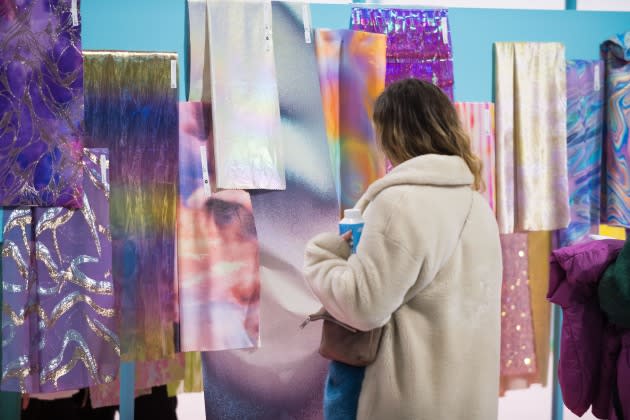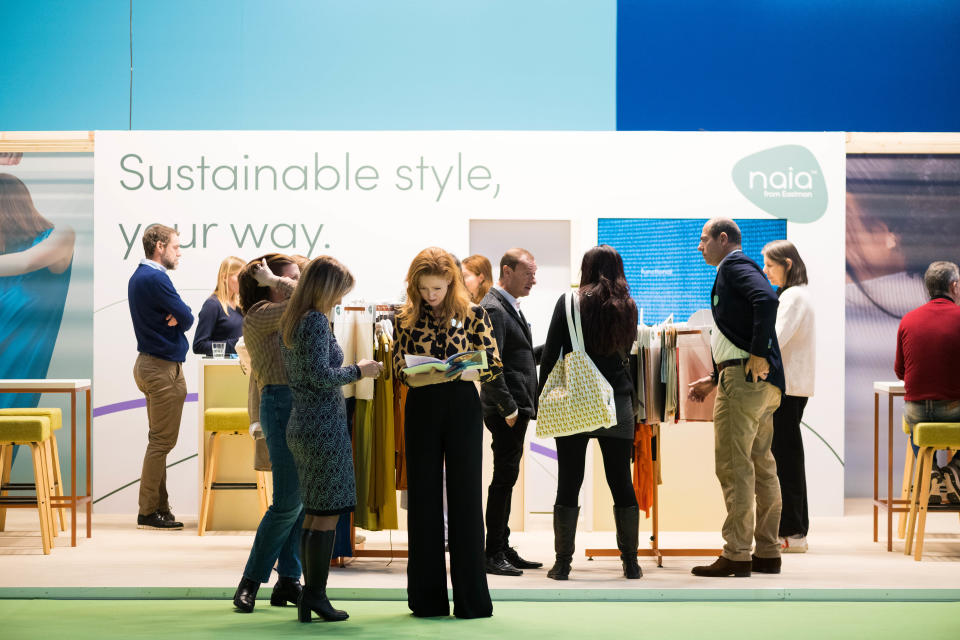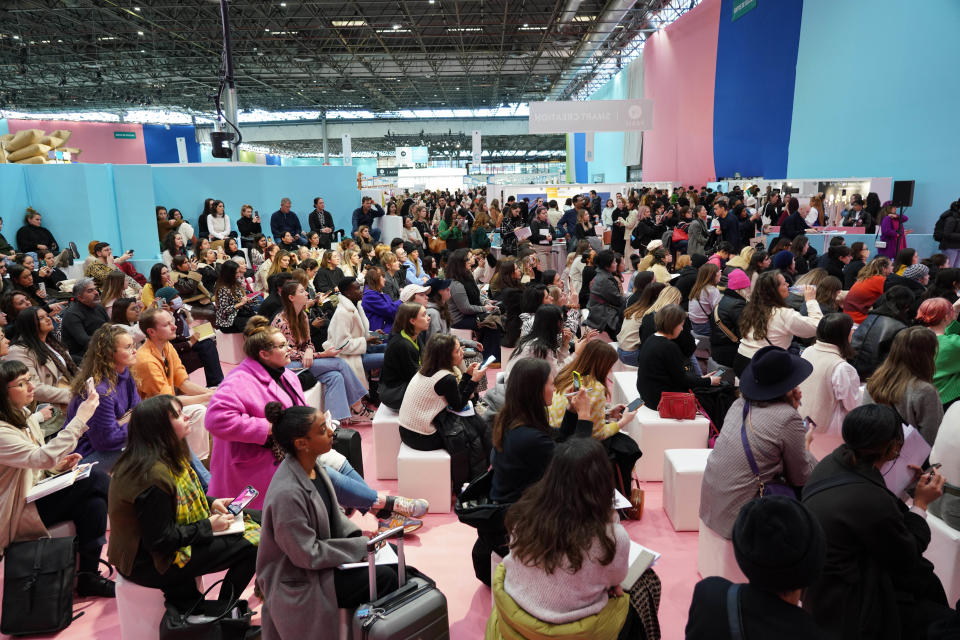Première Vision and Texworld Mark Full Return in a Fashion World in Transition
- Oops!Something went wrong.Please try again later.

PARIS — With a host of new features plus talks on the regulatory outlook, the Première Vision trade show here drew big-name designers, sourcing teams and professionals from 118 countries to an offer of 1,246 exhibitors.
The first edition since the pandemic to welcome back every country, the event held earlier this month was dynamic, even within a context of climate breakdown, inflation and ongoing conflict. The show’s Smart Creation zone, for innovators addressing environmental impact, was among one of the buzziest.
More from WWD
“Finally, we’re back to the show in Paris after three years,” said designer Uma Wang, who’d made the trip from China for her first in-person visit to her label’s Italian suppliers since the start of the pandemic. “I’m happy to see the energy; so many people have come back. I’ve seen a lot of designers,” she said.
“It’s the first full show since February 2020,” said British designer Nigel Cabourn, who’s been buying fabrics since 1971. He noted the return of Japanese and Italian exhibitors, naming technical wear by Italian mill Serates as his standout at this edition.
“It’s back to how it was before in terms of the number of exhibitors and the right exhibitors,” concurred designer Walter Van Beirendonck, who’s been coming since the ’80s. “I’m really enjoying coming to this fair and searching myself. A lot of designers skip it,” he said.
In terms of novelty, the Belgian designer said “in general it’s rather safe what’s happening. I’m missing that new excitement — not necessarily funky as in bright and colorful, but excitement in more natural ways. Adventurous developments can go in every direction,” he added.
“The show was definitely buzzing this time, lots of excitement,” said Debra Polanco, creative director of Sanctuary Clothing, lauding the trend display areas. “As we are a visual industry, they really speak to designers. The color direction was very inspiring,” she added. “I thought Italian print house Lisa’s prints were exceptional; I’m loving all their new large-scale prints.”

Highlights at Maisons d’Exceptions, the craftmanship showcase which marked its return this season, included Anne Gelbard, whose handmade secret application techniques create volume and relief on top of a diversity of base fabrics.
Browsing the showcase, whose entrance was strictly controlled, Annabelle Lacuna, womenswear designer at Off-White, was among professionals returning after a hiatus of several years. “I’m here to see the new developments in terms of fabrication, textures and craftsmanship,” she said. Lacuna also creates accessories for Jacquemus and her own namesake jewelry line.
Naming the color direction of fake furs as a highlight, Lacuna was on the hunt for recycled materials for Off-White’s September show. “Everything starts from the fabrication, the detail in the fabrics. It’s the storytelling for each garment. It’s fantasy, and then back to earth, back to reality of pricing,” she said.
Yvette Herbert, product development accessories manager at U.K. department store Liberty, approved of the show’s size. “I haven’t been here for a few years; it’s not as big as I remember it. The first time I came, I’m pretty sure every hall was open; it was much bigger and I remember thinking, ‘I can’t do this,’” she said. “This feels a lot more manageable.”
The show’s dedicated Smart Tech area pairing the boom in traceability start-ups alongside digital design innovators was among the biggest draws, as was the talk zone, which addressed what lies ahead for sourcing strategies, featured industry innovations like mycelium materials, and included a key update from textile industry lobbying group Euratex general director Dirk Vantyghem on upcoming European Union regulations.
While many designers and sourcing teams seemed unaware of this looming legislation, Vantyghem gave the audience a comprehensive overview of what to expect under the wide-reaching EU Strategy for Sustainable and Circular Textiles.
With the regulatory framework, all textile products placed on the EU market must be durable, repairable and recyclable, to a great extent made of recycled fibers, free of hazardous substances and produced respecting social rights. “If you don’t fit with that definition, your product will not be allowed into the EU anymore,” Vantyghem said.
Regarding legislation related to due diligence, Vantyghem noted that brands and retailers will be liable for their entire manufacturing pipeline, and will no longer able to claim they don’t know what’s happening in the supply chain.
The ultimate goal is to reduce the industry’s environmental impact on a level playing field. “The EU wants to make sure that essentially textiles companies — whether they’re based here in France or in Bangladesh or in Brazil or in the U.S. — compete on the same basis and comply with the same environmental and social standards that create transparency within this global competitive market,” Vantyghem said.
The 16 pieces of legislation are still winding their way through the legislative wheels, with Vantyghem estimating a three- to five-year timeframe for enforcement. While an audience member called the timescale “extremely ambitious and unrealistic,” Vantyghem noted the members of the EU Commission have one year left on their five-year term and want to push through as much legislation as possible.

He also addressed audience concerns about the potential impact on workers in key production countries if sustainability drives up fast fashion prices. Vantyghem suggested a lower value-added tax of 6 percent for garments produced to social and environmental standards, compared to the standard 21 percent. The effect would make responsibly produced garments more appealing to the price-conscious consumer.
Closing his remarks, Vantyghem said that while many companies are “scared” of the new regulations, the industry needs to work together to come up with solutions.
French start-up FairlyMade is among those offering to help sourcing teams with compulsory environmental labeling.
“The fashion sector hasn’t been regulated, it’s a lot of work, it’s hard to put into place; that’s why we propose a turnkey solution,” said cofounder Laure Betsch. To comply with France’s Anti-Waste and Circular Economy Law, FairlyMade promises to both track the full journey of products and calculate Scope 3 emissions impact, plus show areas for improvement. Consumers access the information through a QR code.
“In the beginning it was by intuition, and now it’s by data,” said Betsch, who worked in sourcing at H&M before cofounding the company five years ago with Camille Le Gall, whose experience includes Chanel and Louis Vuitton. “People were putting energy into changing a polyester yarn into a recycled polyester yarn even though it was 20 percent of the product. That’s not the biggest leverage. Today we can see where the greatest impact is.”
The company, whose clients include luxury conglomerate LVMH Moët Hennessy Louis Vuitton, recently closed a 5-million-euro seed funding round from U.K.-based ETF Partners and early stage investment fund FrenchFounders.
Meanwhile, Texworld drew 8,000 visitors from 115 countries, more than double the attendance at last July’s edition, with organizers summing up the event as a “long-awaited reopening to the world.”
Among 450 exhibitors from China making their return, Bor‘nature was doing brisk business with its collection of natural fabrics — made from corn or recycled plastic, and dyed with plants and alternatives. “From the first day until now, my stand’s been full every single minute,” said chief executive officer Lixing Dong. Bor‘nature supplies players like Zara and Costco.
Looking for fabrics for tailoring and occasion wear, Lisa Houghton, senior designer for Next, said sustainability criteria and import duties are impacting choices for the U.K. high street retailer.
“We’re having to consider everything, the labeling, where the yarn’s come from,” she said. “We’ve got rising costs from every angle with the exchange rates. A few suppliers are making sustainability more cost-neutral,” she said, citing big volume basics like zippers and naming YKK showing at Première Vision as an example.
“Even fabric agents now are reconsidering how to be competitive, with unbleached yarns […]. There’s a lot more stripping back,” she said. Yet she cautioned against being overly optimistic about the speed of change. “We’re creatures of habit; we’re lazy still. It’s baby steps until it’s a giant step and not shouting about it until you can.”
New signage features at the show marking sustainability and small quantities were a hit with sourcing teams. “It really helps, we’re looking for small quantities,” said Mathilde Rouza of Belgian supplier Tonickx, which works with La Redoute and Klass. She was carrying a swatch in her bag from a client who’d tasked her to find a specific fabric, with no information whatsoever on the composition.
Browsing Mahavir Tex Prints for the first time at Texworld, Will Cooper, director of Core 37 Limited, was among those reconsidering sourcing geography for his online underwear and sports manufacturing business. “A lot of the stuff we produce is cotton, so we need to make sure it’s the right cotton. We’re trying to bring it nearer to home, produce in Europe rather than the Far East, because there’s less of a footprint then. It’s difficult; we’re trying to find suppliers in Portugal, potentially some areas of Turkey,” he said.
For Texworld’s next edition, the show revealed its move to Porte de Versailles, with 1,300 exhibitors expected, and a planned increase in participation of Chinese, Indian, Turkish, South Korean, Vietnamese, Ghanaian and Ethiopian manufacturers.
The move will make the show concurrent with the Salon International de la Lingerie and Interfilière organized by WSN. “This strategic choice was made in response to strong demand from buyers, who want to be able to take advantage of an extended sourcing platform at this time of year, just minutes from Paris,” said Frédéric Bougeard, president of Messe Frankfurt France.
Best of WWD

